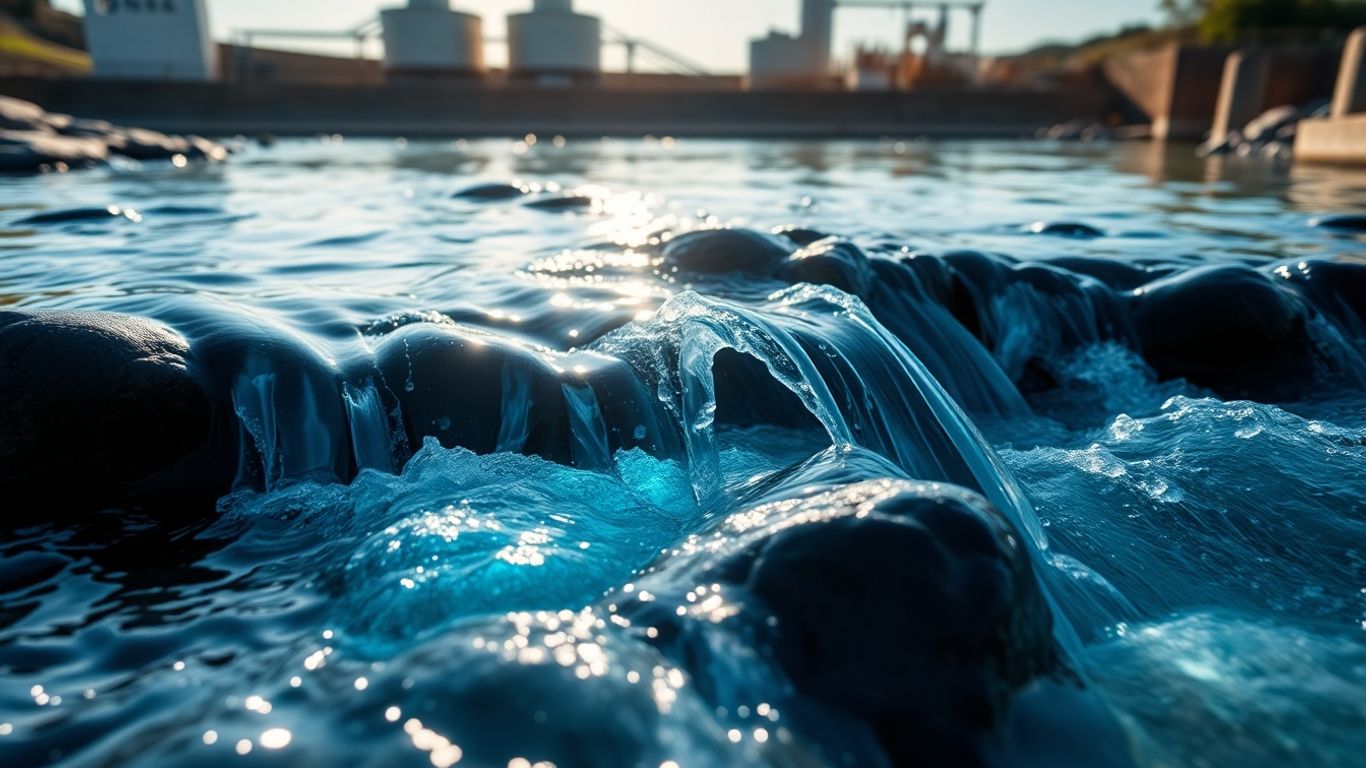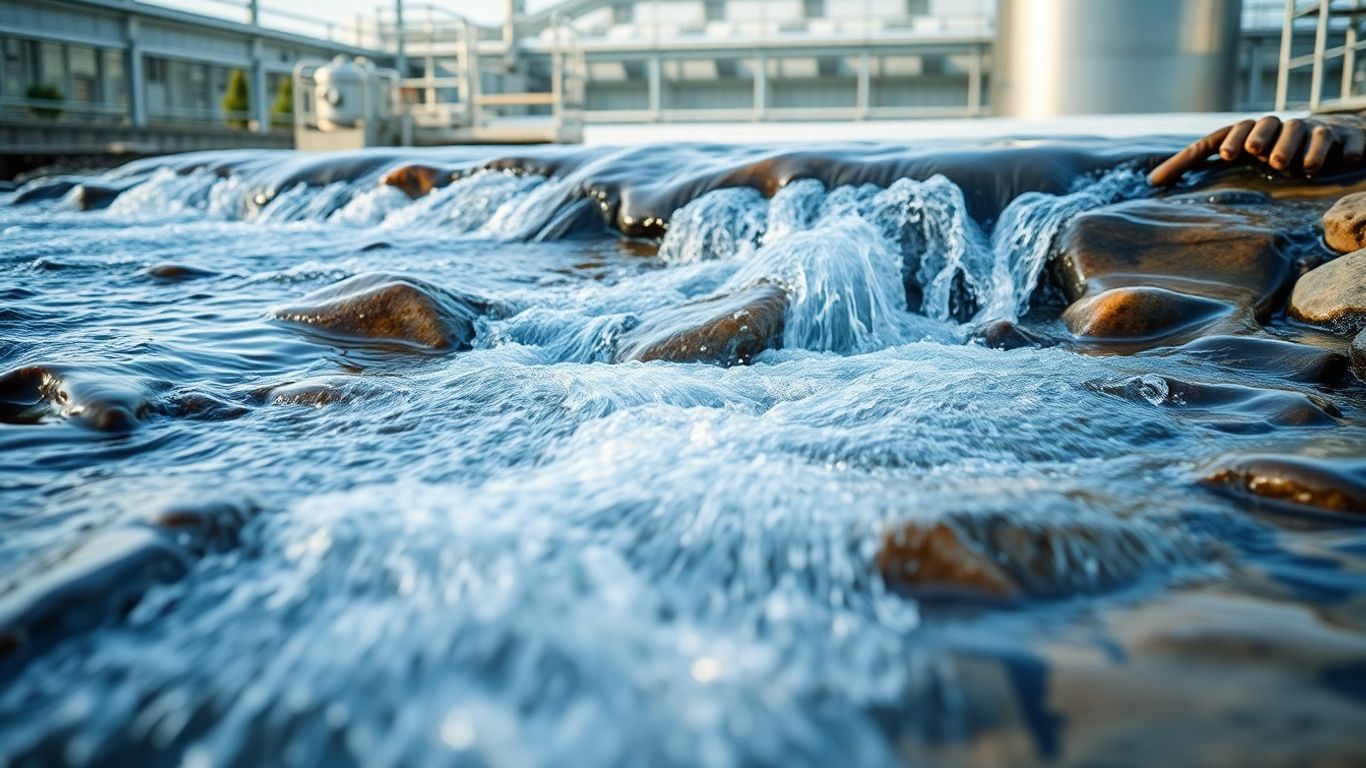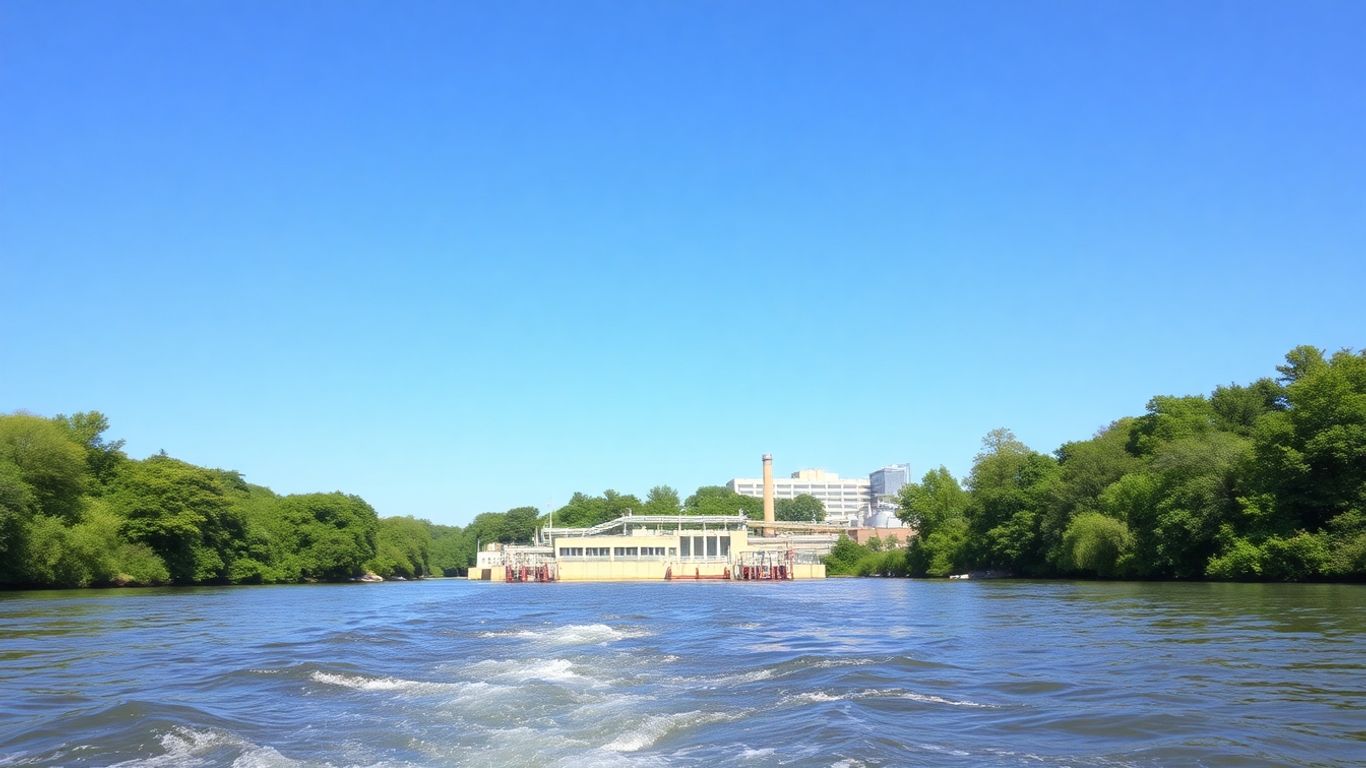- September 19, 2025
- - In category: Blog
You know, thinking about where our tap water comes from and how it gets to our homes can be a bit of a mystery. For folks in Ottawa, the city has a pretty solid system in place to make sure the water you drink is safe. It involves a lot of steps, from the river all the way to your faucet. Let’s break down how the city of Ottawa’s water treatment process works and what it means for your home’s plumbing.
Key Takeaways
- The city of Ottawa gets its water mainly from the Ottawa River, with some water coming from underground wells, too.
- The water goes through a cleaning process with several stages: clumping particles, filtering, settling, and disinfection to kill germs.
- Ottawa’s water treatment plants follow strict rules and do lots of tests each year to keep the water safe.
- Even though the city treats the water well, older homes might have old pipes that could add lead to the water.
- You can find reports on water quality from the city, and they have ways for you to report any water issues you notice.
Understanding the City of Ottawa Water Treatment System
When you turn on the tap in Ottawa, the water that comes out has been through a pretty involved cleaning process. The city really puts effort into making sure the water you drink is clean and safe. Most of this water starts its journey in the Ottawa River, and then it heads to one of two main places for a serious scrub-down: the Lemieux Island or Britannia water treatment facilities.
This isn’t just a quick splash and dash. It’s a multi-step operation designed to remove all sorts of things you wouldn’t want in your drinking water. Think of it like a very thorough cleaning for something as important as your daily water.
Here’s a general idea of what happens:
- Particle Clumping: First, they add special stuff to the water that makes tiny particles stick together. These bigger clumps, called floc, are easier to catch later on.
- Settling and Filtering: Next, the water sits in large tanks, letting the heavier clumps sink to the bottom. After that, it’s pushed through filters, kind of like a super-fine sieve, to catch anything still floating around.
- Germ Killing: Even after all that, there might be tiny germs left. So, they add a disinfectant, usually chlorine, to make sure any remaining bacteria or viruses are zapped.
- Balancing Act: Finally, they adjust the water’s chemistry a bit to make sure it’s not too acidic or too alkaline. This helps protect the pipes it travels through and makes it just right for drinking.
The whole point is to take water from a natural source, which can have all sorts of things in it, and make it perfectly safe and clean for everyone in the city to drink, day in and day out.
It’s a complex system, but it’s all about making sure that when you fill up a glass, you can trust what you’re drinking.
Overview of Ottawa’s Water Sources
When you turn on the tap in Ottawa, the water you get has a journey behind it. The city’s municipal water supply primarily comes from one major source: the Ottawa River. This vast river is the main provider, feeding into our treatment plants to begin its transformation into safe drinking water. It’s a pretty impressive system, really, considering the sheer volume of water needed for a city this size.
But the Ottawa River isn’t the only player. The city also taps into a network of six groundwater well systems spread across different areas. These underground sources offer a different kind of water, often with a higher mineral content compared to the river water.
Here’s a quick look at the different sources:
- Ottawa River: The main surface water source, providing the bulk of the city’s water.
- Groundwater Wells: Six distinct well systems located in various parts of the city, offering an alternative supply.
While the Ottawa River is the primary source, the inclusion of groundwater wells adds a layer of resilience to the city’s water supply strategy. It means that even if there are issues with the river, there’s still a backup to keep the taps flowing.
It’s important to remember that both river water and groundwater have their own unique characteristics. River water can sometimes have a more ‘earthy’ smell or taste, which is perfectly normal and a sign of its natural origin. Groundwater, on the other hand, might have different mineral compositions. Regardless of the source, the city’s treatment process is designed to handle these variations and make the water safe and clean for everyone.
The Step-by-Step Process of the City of Ottawa Water Treatment System
When you turn on the tap in Ottawa, the water has already been through a pretty thorough cleaning. It’s not just a quick rinse; the city uses a multi-stage Ottawa water purification process to make sure what comes out is safe to drink. Most of the water starts its journey in the Ottawa River, and then it heads to one of the two main treatment plants.
The process is designed to remove all sorts of things, from tiny particles to microscopic organisms. Here’s a look at the main steps involved:
- Coagulation and Flocculation: First off, chemicals are added to the water. These chemicals help the really small, suspended particles clump together. Think of it like static electricity making dust bunnies form. These bigger clumps, called floc, are much easier to remove later on.
- Sedimentation: After the floc forms, the water sits in large tanks. This allows the heavier floc to settle to the bottom, kind of like mud settling in a pond. The clearer water is then drawn off from the top.
- Filtration: Even after settling, there might still be some small bits left. So, the water is passed through filters. These are usually made of layers of sand, gravel, and charcoal. This step catches most of the remaining particles and impurities.
- Disinfection: This is a really important step. To kill any remaining bacteria, viruses, or other germs that might have survived the earlier stages, chlorine is added. This makes the water safe from harmful microorganisms. The city monitors chlorine levels closely to make sure it’s effective but not too much.
- pH Adjustment: Finally, the city adjusts the water’s pH level. This is done to make the water less corrosive, which helps protect the pipes it travels through on its way to your home. It also makes the water more pleasant to drink.
This whole process is carefully managed at facilities like the Lemieux Island and Britannia plants. They are designed to handle large volumes of water and meet strict safety standards. Reducing wastewater flows also helps protect our water sources protect water sources.
The goal is to have clean, safe water leaving the plant, but it’s worth remembering that older homes might have plumbing that could affect water quality once it reaches your tap. The city does a lot of work to make sure the water is pure before it even leaves its control.
Key Water Treatment Facilities in Ottawa
Ottawa’s commitment to providing safe tap water relies on two main treatment plants: the Lemieux Island Water Purification Plant and the Britannia Water Purification Plant. These facilities are the workhorses of the Ottawa water services, taking raw water from the Ottawa River and transforming it into the clean, safe water that flows into our homes. Each plant uses a multi-stage process to remove impurities and ensure the highest quality.
While the city handles the treatment at the plant level, it’s worth remembering that what happens within your home plumbing systems can also play a role in your water experience. Older homes, for instance, might have older pipes that could potentially affect water quality. This is where understanding the city’s efforts and considering home solutions like water filtration services or even water softeners can be beneficial, especially if you have specific concerns about taste or mineral content.
Here’s a simplified look at what happens at these facilities:
- Coagulation and Flocculation: Chemicals are added to make tiny particles stick together, forming larger clumps.
- Sedimentation: These clumps settle to the bottom, removing them from the water.
- Filtration: Water passes through filters (like sand and gravel) to catch remaining small particles.
- Disinfection: Chlorine or other disinfectants are used to kill any remaining harmful microorganisms.
- pH Adjustment: The water’s acidity is balanced to protect pipes and make it safe for drinking.
The city conducts a massive number of tests each year, well over 100,000, to make sure the water leaving these plants meets all safety standards. This constant vigilance is a big part of why Ottawa’s water is considered safe to drink straight from the tap. They are always looking into new ways to improve the process too.
Beyond the treatment plants, Ottawa also utilises several groundwater well systems, which are also monitored closely. While the city ensures the water is safe when it leaves the plant, if you’re concerned about your home’s specific plumbing or want to further refine your water quality, options like water heater services or specialised filtration systems can be explored. Ottawa Public Health provides annual reports detailing the quality of water from each source, so you can stay informed.
Water Quality Monitoring and Safety Compliance
So, how does the city actually know the water is safe before it even gets to your tap? It’s a pretty involved process, honestly. They don’t just treat it and hope for the best. Ottawa’s water treatment plants are constantly being checked and tested. Think of it like a doctor giving you a regular check-up, but for water. They’re looking for all sorts of things to make sure everything is just right.
Here’s a peek at what goes into it:
- Regular Testing: The city conducts a huge number of water quality tests every single year – we’re talking over 100,000! These tests look at everything from how clear the water is to the levels of different minerals and chemicals. They want to catch any little thing that might be off.
- Meeting Standards: All this testing isn’t just for show. The results are compared against strict rules set by both the province and the federal government. The goal is always to meet, and often beat, these safety requirements.
- Advanced Equipment: The treatment plants themselves use sophisticated equipment to monitor water quality in real-time. This means they can spot issues almost as they happen and make adjustments.
It’s a big responsibility, making sure that water coming out of your faucet is clean and safe to drink. The city puts a lot of effort into monitoring and testing at every stage of the treatment process. They’re really committed to keeping the water quality high.
While the water is super clean when it leaves the treatment plant, it’s worth remembering that what happens inside your home’s pipes can sometimes make a difference. Older homes, for example, might have plumbing that could potentially add things like lead to the water. The city does work to manage this, but it’s good to be aware of it. If you’re ever worried about your home’s water, the city actually offers free testing for things like lead. They want you to feel confident about the water you’re drinking.
How Residents Can Access Water Quality Reports
 Keeping tabs on your tap water’s quality is easier than you might think. The City of Ottawa is pretty upfront about its water treatment process and makes the results available to everyone. You can find detailed water quality reports right on the city’s website. These reports give you the lowdown on how the water is treated and whether it meets all the safety rules. It’s a good way to see what’s happening with the water in your specific area.
Keeping tabs on your tap water’s quality is easier than you might think. The City of Ottawa is pretty upfront about its water treatment process and makes the results available to everyone. You can find detailed water quality reports right on the city’s website. These reports give you the lowdown on how the water is treated and whether it meets all the safety rules. It’s a good way to see what’s happening with the water in your specific area.
Here’s how you can get your hands on this information:
- Visit the City of Ottawa’s official website. Look for the section dedicated to water services or water quality.
- Search for annual water quality reports. These are usually published for each treatment plant and well system.
- Utilise the online Water Testing Portal. This is a handy tool for managing your water quality information and submitting testing requests if needed.
The city conducts over 100,000 tests each year, so there’s a lot of data to go through. These reports are designed to be informative, showing you the results of various tests performed to keep your water safe.
If you ever notice something off with your water, like a strange colour or smell, don’t hesitate to reach out. You can call 613-867-4082 to report issues or get assistance. It’s all part of making sure everyone in Ottawa has access to clean, safe drinking water every day.
Conclusion: Ensuring Safe Drinking Water in Ottawa
So, we’ve walked through how the City of Ottawa Plumbers treats its water, from the river to your tap. It’s a pretty involved process, and the city really puts in the work to make sure the Ottawa drinking water quality is up to par. They’re not just meeting standards; they’re aiming to exceed them.
The city’s commitment to safe water is evident in its rigorous testing and advanced treatment methods. But it’s also a shared responsibility. While the treatment plants do their job, what happens in our homes matters too. Older plumbing, for instance, can sometimes introduce issues like lead, even after the water has been perfectly treated.
Here’s a quick rundown of what keeps our water safe:
- Advanced Treatment: Multiple stages, like filtration and disinfection, remove impurities and kill germs.
- Constant Monitoring: Over 100,000 tests are done each year to check water quality.
- Regulatory Compliance: Ottawa’s system adheres to strict provincial and federal rules.
- Public Access: Detailed water quality reports are available for anyone to review.
While the city’s water treatment is robust, residents with older homes should be aware of their plumbing. The city offers resources, like free lead testing, to help address potential concerns that can arise after the water leaves the treatment facility.
Ultimately, having clean, safe drinking water is something we can count on in Ottawa, thanks to the city’s efforts and our own awareness.
Keeping your drinking water clean and safe in Ottawa is super important. If you’re worried about your water quality or need a check-up, don’t wait! Visit our website today to learn more about how we can help ensure your tap water is healthy for your family. We offer expert solutions for all your water needs.
Frequently Asked Questions
Is Ottawa’s tap water safe to drink?
Absolutely! Ottawa’s tap water is safe to drink. The city follows strict rules and conducts over 100,000 tests each year to make sure the water is clean and safe for everyone.
Where does Ottawa get its drinking water from?
Most of Ottawa’s drinking water comes from the Ottawa River. The city also uses water from six underground well systems to provide water to different parts of the city.
How does the city treat the water?
Ottawa’s water goes through a detailed cleaning process at two main treatment plants. This includes steps like clumping small particles together, filtering out dirt and other bits, and using chlorine to kill any germs, making sure the water is safe to drink.
Can Ottawa’s tap water have lead in it?
The water is lead-free when it leaves the treatment plants. However, in some older homes, the water might pick up a little lead from old pipes. The city offers free lead testing if you’re worried about this.
How can I find out about the water quality in my neighbourhood?
You can find detailed water quality reports on the City of Ottawa’s website. These reports explain how the water is treated and confirm that it meets all the safety rules.
What should I do if I think there’s a problem with my tap water?
If you notice anything unusual with your water, like a strange colour or smell, you should contact the City of Ottawa. You can call 3-1-1 to report problems or get help.



